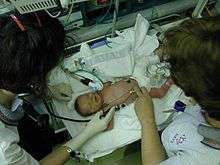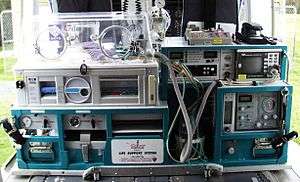Newborn transport
Newborn transport[1] is used to move premature and other sick infants from one hospital to another, such as a medical facility that has a neonatal intensive care unit and other services. Neonatal transport services such as NETS use mobile intensive care incubators fitted with mechanical ventilators, infusion pumps and physiological monitors capable of being used in a mobile environment.[2] These transport systems seek to emulate the environment of a neonatal intensive care and permit uninterrupted care to occur in a referring hospital and then during the journey by road or air ambulance. Power and medical gas supplies are carried within the system as well as making use of external supplies; as available. Infant transport systems commonly weigh over 100 kg and present a challenge to vehicle operators in terms of weight, manual handling, crashworthiness and power consumption.


Normally, regular ambulance staff and their vehicles are not equipped to transport sick newborns and special newborn transport teams are provided from either particular hospitals (hospital-based) or established to serve many hospitals (regionally based). Team composition varies from one country to another, with options including various two or three person combinations of nurse, doctor and respiratory therapist. Access to neonatal transport also varies, particularly in developing countries. [3]
Typically, newborn transport teams spend some time stabilizing a baby's condition prior to transport. Without adequate stabilisation, a clinical deterioration en route may occur.
Wherever possible (and safe), in utero transfer is generally preferable to newborn transport.[4] Transfer of the mother while still pregnant leads to improved survival and quality of survival for the baby.
References
- "What is a Pediatric Transport Team?". HealthyChildren.org. Retrieved 2020-04-30.
- Bellini, Carlo; de Biasi, Martina; Gente, Maurizio; Ramenghi, Luca A.; Aufieri, Roberto; Minghetti, Diego; Pericu, Silvia; Cavalieri, Martina; Casiddu, Niccolò (2019-08-07). "Rethinking the neonatal transport ground ambulance". Italian Journal of Pediatrics. 45 (1): 97. doi:10.1186/s13052-019-0686-y. ISSN 1824-7288. PMC 6686524. PMID 31391074.
- Niermeyer, Susan; Domek, Gretchen; Pan American Health Organization (2016). "Neonatal transport in developing country settings: a systematic review". CLAP/WR Scientific Publication. 1605-02 – via WHO IRIS.
- Whyte, Hilary Ea; Jefferies, Ann L.; Canadian Paediatric Society, Fetus and Newborn Committee (June–July 2015). "The interfacility transport of critically ill newborns". Paediatrics & Child Health. 20 (5): 265–275. doi:10.1093/pch/20.5.265. ISSN 1205-7088. PMC 4472056. PMID 26175564.CS1 maint: date format (link)